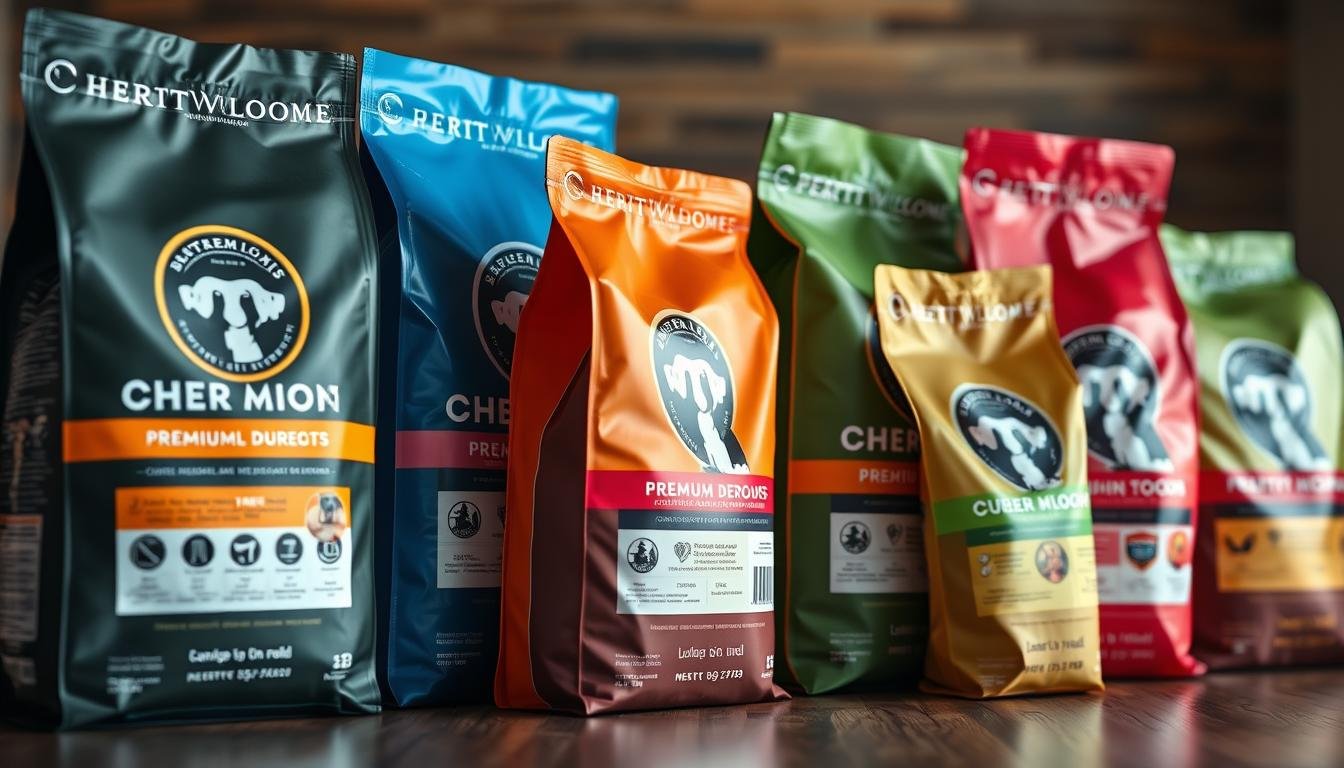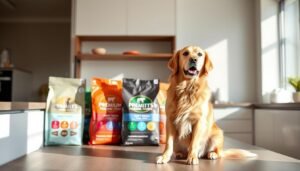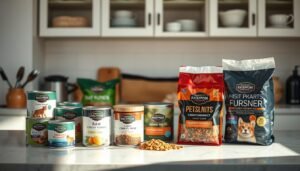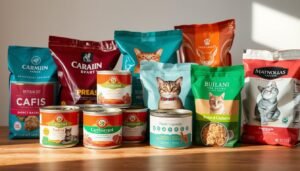I always wanted the best for my dog. When my lab mix, Bailey, got sick, I knew I had to find the right food. My vet told me to pick food that’s good for Bailey and meets his needs.
I looked for dog food that’s top rated and vet approved. I wanted food that keeps Bailey healthy and happy. This search led me to learn about quality standards for dog food.
I found out about the Association of American Feed Control Officials (AAFCO). They make sure dog food has the right nutrients. But what really helped was talking to vets who know a lot about animal nutrition.
If you want the best for your dog, this article has a list of great brands. They use quality ingredients and taste good. Your dog will love their food and stay healthy. You can learn more about vet recommended dog food here: valuable resource.
Key Takeaways
- Choosing quality dog food is essential for your dog’s health.
- Vet recommendations are based on clinical experience and research.
- It’s important to consider the nutritional needs of your dog.
- Top rated dog food often features high-quality ingredients.
- Keep an eye on brands verified for their adherence to AAFCO standards.
Understanding Dog Food Labels
Choosing the right food for my dog is key. Dog food labels can be tricky to read. It’s important to look at the ingredients closely.
Knowing what makes food healthy helps a lot. This makes my dog’s diet better.
How to Read Ingredients
First, I check the ingredients. I look for animal proteins first. This means my dog gets good protein for health.
Ingredients are listed by weight. So, the first ones are the most important. I avoid byproducts and artificial stuff. Instead, I choose natural ingredients for my pet’s health.
The Importance of AAFCO Standards
The AAFCO helps make sure pet food is good. I check if the food meets AAFCO standards. This means it has what my dog needs.
Talking to my vet about this helps me feel sure. It makes me know I’m making the best choice for my dog.
Nutritional Needs for Different Breeds
Dogs need different foods based on their breed. Size, age, and health matter a lot. The right food helps them stay happy and healthy.
Tailoring Diets by Size
Small dogs need lots of energy and special food. Their food should be easy to chew. Big dogs need food that helps their joints.
This helps owners pick the best food for their dog’s size.
Special Considerations for Puppies and Seniors
Puppies grow fast and need lots of protein. They also need lots of calories. Senior dogs need food that’s easy to digest and has important vitamins.
Best Brands Vets Trust
When I look for the best dog food, I check what vets recommend. Brands like Royal Canin and Hill’s Science Diet are top choices. They offer high-quality food for different needs.
Royal Canin: Science-Backed Nutrition
Royal Canin makes food just for certain breeds and health issues. Vets help create these formulas. This ensures dogs get the right nutrients for health.
This brand uses science to make its food. It works for dogs of all sizes and ages. It’s great for my dog’s health.
Hill’s Science Diet: Vet-recommended Choices
Hill’s Science Diet is also a vet favorite. Their food meets dogs’ nutritional needs at every stage of life. They have many products for different health issues.
This focus on balanced nutrition makes me feel good about what I feed my dog. It’s healthy and effective.
Top Dog Foods for Specific Health Issues
Many dogs face health problems that need special diets. For dogs with allergies, grain-free food is a good choice. It cuts down on allergens in regular dog food. For weight issues, special recipes help keep dogs healthy.
Grain-Free Options for Allergies
Grain-free dog food is popular for dogs with allergies. Many vet-approved brands make grain-free food. This food reduces allergy chances. Here are some top picks:
| Brand | Key Ingredients | Benefits |
|---|---|---|
| Blue Buffalo Wilderness | Deboned Chicken, Peas, Blueberries | High-protein, enhances muscle maintenance |
| Orijen Original | Fresh Chicken, Turkey, Fish | Biologically appropriate, mimics natural diet |
| Wellness Core | Turkey, Chicken, Potatoes | Low in carbs, high in protein |
Recipes for Weight Management
Recipes with more protein and less calories help dogs lose weight. Making food that tastes good and is healthy helps dogs lose weight. Here are some tasty and healthy recipe ideas:
- Chicken and Pumpkin Stew: Shredded chicken mixed with pumpkin puree, carrots, and green beans.
- Fish and Sweet Potato Mash: Baked white fish combined with mashed sweet potatoes and peas.
- Turkey Veggie Mix: Ground turkey mixed with broccoli, spinach, and brown rice.
The Benefits of Dry vs. Wet Dog Food
Choosing the right dog food is hard. I often think about the benefits of dry and wet dog food. Each has its own good points and bad points.
Pros and Cons of Dry Food
Dry dog food is easy to store and is cheaper. It’s crunchy, which helps keep teeth clean. Some good things about it are:
- Longer shelf life
- Portion control is easier
- Less mess during feeding
But, dry food has less water. This might not be good for dogs who need more water. Dogs with health issues might find it hard to chew.
Pros and Cons of Wet Food
Wet dog food has more water, which is good for staying hydrated. It smells and tastes better, which dogs like. Some benefits are:
- Higher moisture content
- Tastier and more palatable for some dogs
- Can aid in promoting healthy weight
But, wet food costs more. It doesn’t help keep teeth clean like dry food. It also goes bad faster once opened.
Homemade Dog Food: What You Need to Know
Many pet owners like making homemade dog food. It lets them pick safe ingredients and make food their dog likes. But, making balanced meals needs careful thought about what to add and what to skip.
Knowing which ingredients are safe is key for your dog’s health.
Safe Ingredients for Your Pup
Safe ingredients are the base of homemade dog food. Whole grains, good proteins, and veggies are must-haves. Chicken, fish, and turkey are great for protein. Brown rice and quinoa are good grains. Carrots and spinach add vitamins A and C.
But, some foods are bad for dogs. Onions, garlic, chocolate, and grapes are toxic. Knowing which foods are safe and which to avoid is important.
Balancing Nutritional Needs
When making homemade dog food, it’s important to balance nutrients. Dogs need proteins, fats, vitamins, and minerals. Recipes must be well-planned to avoid missing out on anything.
Getting help from a vet nutritionist is a good idea. They can make sure your dog’s meals are complete and right for their needs.
By mixing these elements, you can give your dog healthy food. This food will help keep them full of energy and joy.
| Ingredient Type | Examples | Benefits |
|---|---|---|
| Proteins | Chicken, Fish, Turkey | Supports muscle growth and overall health |
| Grains | Brown Rice, Quinoa | Provides energy and fiber for digestion |
| Vegetables | Carrots, Spinach | Rich in vitamins and minerals, boosts immune system |
Doggy Diet Trends to Watch
Two big trends in dog food are raw diets and plant-based dog food. More dog owners want food that fits their health and wellness views.
The Rise of Raw Diets
Raw diets give dogs uncooked meats and fresh veggies. It’s like what they ate long ago. People say it makes dogs healthier and gives them shiny coats and lots of energy.
But, there are things to think about:
- Risk of Nutritional Imbalance: It can be hard to make sure dogs get all the nutrients they need.
- Safety Concerns: Raw meats might have bad bacteria.
- Veterinary Guidance: It’s key to talk to a vet to make sure the diet is safe and balanced.
Plant-Based Dog Food
Plant-based dog food is getting popular. It’s good for the planet and is made with care. It’s made with high-quality plant proteins.
Here are some good things about it:
- Reduced Environmental Impact: It uses less resources than meat.
- Allergy Management: It might help dogs with meat allergies.
- Health Benefits: It has lots of vitamins and minerals from veggies.
Budget-Friendly Dog Food Options
Finding cheap dog food can be hard. But, there are many affordable brands that use good ingredients. This way, I can save money without hurting my dog’s health.
Affordable Brands with Quality Ingredients
Some brands are great for cheap dog food without losing quality. Purina Pro Plan, Blue Buffalo Life Protection, and Nutro are good choices. They make food with high-quality protein, vitamins, and minerals.
This ensures my dog eats well every time. Here’s a table showing some affordable brands and what they offer:
| Brand | Protein Source | Price Range | Key Features |
|---|---|---|---|
| Purina Pro Plan | Chicken, Turkey | $40 – $60 for 30 lbs | High protein, Made with real meat |
| Blue Buffalo Life Protection | Chicken, Lamb | $45 – $65 for 30 lbs | Whole grains, Antioxidants |
| Nutro Ultra | Chicken, Salmon | $50 – $70 for 30 lbs | Whole food, No artificial preservatives |
How to Find Good Deals Locally
To save more, I look for deals in my area. I check pet stores and supermarket flyers for sales. Signing up for loyalty programs can also get me discounts.
I also watch for sales and use coupons. Buying in bulk can save money too. This way, I can keep my dog happy and healthy without spending too much.
Transitioning to New Dog Food
When changing dog food, it’s best to do it slowly. Sudden changes can upset their stomach. A 7-10 day gradual change helps them adjust without stress.
Steps to a Smooth Transition
To start, mix a little new food with their old food. Slowly add more new food and less old food. This lets their body get used to the change.
- Days 1-3: Mix 25% new food with 75% old food.
- Days 4-6: Mix 50% new food with 50% old food.
- Days 7-10: Mix 75% new food with 25% old food.
- After Day 10: Serve 100% new food.
Monitoring Your Dog’s Reaction
Watch your dog closely when changing their food. Look for signs like not eating, vomiting, or different poop. If they seem upset, talk to a vet.
Popular Dog Food Tasting Events
Going to dog food events is fun for pet owners. They get to try new foods and learn about nutrition. It’s a great way to find the best food for your dog.
What to Expect at a Dog Food Expo
Dog food expos are lively places for pet lovers. You’ll see demos on how to cook and serve new dog foods. There are:
- Live cooking demos with fresh ingredients.
- Sample tastings from different dog food brands.
- Expert talks on nutrition for different breeds.
These events teach you about food benefits for your pet’s health.
Engaging with Brands and Experts
Talking to brand reps is special. You can ask questions and share your dog’s needs. Vets at these events give great advice on:
- Choosing the right food for your pet’s health.
- Understanding nutritional benefits of ingredients.
- Finding allergens in dog food.
These events are great for learning and meeting other dog lovers. Every visit helps you pick a healthy and tasty diet for your dog.
Dog Food Storage Tips for Freshness
Storing dog food right is key to keeping your pet healthy. I use airtight containers for dry food. This keeps it fresh and safe from bad stuff.
I also store food in a cool, dry spot. It should be under 80°F. Heat can ruin the food’s good stuff.
Best Practices for Storing Dry Food
For dry food, I keep it in its bag in a sealed container. This helps me find the important info like the UPC code and “best by” date. If I move it, I use a clean, dry container.
It’s also important to clean the container often. This keeps it ready for the next batch of food.
Keeping Wet Food Safe and Tasty
Wet food goes in the fridge at 40°F or below. Always seal cans or pouches well. Check leftovers often to keep them fresh.
By following these tips, I know my dog eats the best food. For more info, check the FDA’s guidelines on pet food storage.





















